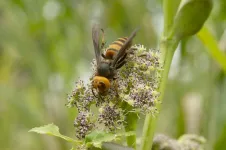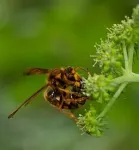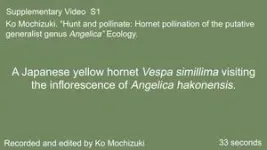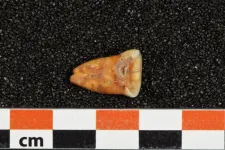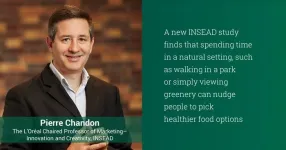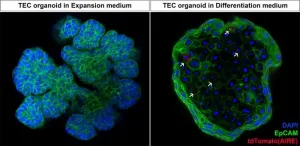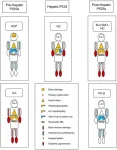(Press-News.org) Researcher Ko Mochizuki of the University of Tokyo discovered that two species in the genus Angelica are pollinated primarily by hornets. This overturns the conventional belief that Angelica species are “generalists,” meaning that there is not one primary pollinator but a variety of species. As hornets are rarely primary pollinators, the discovery also impacts future ecological research and conservation efforts. The findings were published in the journal Ecology.
White, small, open, secretes nectar and produces pollen: these are the kinds of flowers that many types of insects can reach and are attracted to. Most of the plants in the carrot family, Apiaceae, fit this description perfectly. As such, the species in this family are considered to be generalists. In extreme cases, over 100 different insect species visit their flowers. Not so with Angelica decursiva and Angelica hakonensis, two species in the genus Angelica in the family.
“I observed a fierce visitation by hornets for the first time in 2015 in Nagano Prefecture,” Mochizuki recalls, “and then again in 2018 in the Nikko Botanical Garden where they were feeding on the nectar of the inflorescences of A. decursiva and A. hakonensis. Since it was a dogma that species in the family Apiaceae are generalists, this observation motivated me to investigate if the two Angelica species were pollinated predominantly by hornets.”
Confirming the hunch was a stepwise process. First, Mochizuki returned to the Nikko Botanical Garden to quantify the numbers and types of "visitors" to the flowers. Then, he captured some visitors to check the amount of pollen stuck to their bodies to verify whether it would be enough for pollination. Finally, he conducted an experiment in which he covered some flowers with a mesh that blocked the hornets and some flowers with a mesh that blocked all insects, with a third group of flowers remaining uncovered as the control group. All three of these methods showed that hornets were the most numerous species that visited the flowers.
“Nevertheless, excluding hornets resulted in seed production higher than expected. I think excluding the hornets allowed other visitors to gather on the flowers. Especially considering that I had previously observed hornets hunting and killing other insect visitors when they encountered each other on the inflorescence,” Mochizuki explains.
Science advances by incremental steps. Discovering that hornets are the primary pollinator of certain species is one such incremental step, but the consequences are wide-ranging.
“Hornets are generally considered pests in their native range and problematic invasive species in some areas such as North America. Nevertheless, this study underscores the importance of hornets as pollinators, opening new avenues for research and conservation,” says Mochizuki.
END
Hornets found to be primary pollinators of two Angelica species
New research overturns the conventional belief that Angelica species do not have a primary pollinator
2024-04-29
ELSE PRESS RELEASES FROM THIS DATE:
Aspirin vs placebo as adjuvant therapy for breast cancer
2024-04-29
About The Study: In this randomized, placebo-controlled clinical trial that included 3,020 patients with high-risk nonmetastatic breast cancer, daily aspirin therapy did not improve risk of breast cancer recurrence or survival in early follow-up. Despite its promise and wide availability, aspirin should not be recommended as an adjuvant breast cancer treatment.
Authors: Wendy Y. Chen, M.D., of the Dana Farber Cancer Institute in Boston, is the corresponding author.
To access the embargoed study: Visit our For The Media ...
Association of new-onset seizures with SARS-CoV-2 vaccines
2024-04-29
About The Study: This systematic review and meta-analysis showed that the incidence proportion of new-onset seizures after SARS-CoV-2 vaccination was not statistically different between vaccine recipients and placebo recipients or unvaccinated participants in the pooled analyses of more than 118,000 participants in randomized clinical trials.
Authors: Churl-Su Kwon, M.D., M.P.H., of Columbia University in New York, is the corresponding author.
To access the embargoed study: Visit our For The Media website at this link https://media.jamanetwork.com/
(doi:10.1001/jamaneurol.2024.0967)
Editor’s Note: Please see the article for additional information, including ...
How can forests be reforested in a climate-friendly way?
2024-04-29
Europe's forests have already been severely affected by climate change. Thousands of hectares of trees have already died due to drought and bark beetles. Scientists from the University of Vienna and the Technical University of Munich TUM have now investigated which trees can be used for reforestation. Their findings: only a few tree species are fit for the future, such as English oak in the UK. However, mixed forests are important for the survival of forests, otherwise the forest ecosystem as a whole could be weakened. The results of the study were recently published in the renowned journal Nature Ecology and Evolution.
Although European forests are naturally home to a ...
More plants on the menu of ancient hunter-gatherers
2024-04-29
Conducted by an international team of scientists from the Max Planck Institute for Evolutionary Anthropology (Leipzig, Germany), Géoscience et Environnement Toulouse (Toulouse, France), and the Institut National des Sciences de l’Archéologie et du Patrimoine (Rabat, Morocco), the study examines the diet of individuals associated with the Iberomaurusian culture discovered in the cave of Taforalt, Morocco. Using a comprehensive multi-isotopic approach, including zinc and strontium isotope analysis in dental enamel, carbon, nitrogen, ...
The aspirin conundrum: navigating negative results, age, aging dynamics and equity
2024-04-29
WASHINGTON – A new study examining the role of aspirin in breast cancer treatment reveals critical issues related to health equity and aging that have broad implications for cancer and other disease intervention trials, say researchers from Georgetown University’s Lombardi Comprehensive Cancer Center. They outline their concerns in an editorial accompanying the study’s findings published April 29 in the JAMA (“The Aspirin Conundrum: Navigating Negative Results, Age, Aging Dynamics and Equity”).
The ...
Cancer screening rates are significantly lower in US federally qualified health centers
2024-04-29
HOUSTON and ALBUQUERQUE, N.M. ― A national study led by researchers at The University of Texas MD Anderson Cancer Center and The University of New Mexico (UNM) Comprehensive Cancer Center found major gaps in breast, cervical and colorectal cancer screening use in Federally Qualified Health Centers (FQHCs) in the U.S., relative to overall screening rates in the country.
The findings, published today in JAMA Internal Medicine, revealed screening use in FQHCs was 45.4% for breast cancer, 51% for cervical cancer and 40.2% for colorectal cancer, compared to cancer screening rates in the general American population of 78.2%, 82.9% and 72.3%, respectively.
“FQHCs ...
Nature's nudge: Study shows green views lead to healthier food choices
2024-04-29
Natural scenery typically conjures up positive emotions and a sense of wellbeing for most individuals. A new study by INSEAD shows that verdant views can also nudge people to pick healthier food.
Published in Communications Psychology, a new journal by Nature, the study suggests that spending time in a natural setting, such as walking in a park (vs. on city streets), or simply viewing greenery outside the window (vs. an urban view), leads people to make healthier food choices afterward.
“Our ...
AI algorithms can determine how well newborns nurse, study shows
2024-04-29
A modified pacifier and AI algorithms to analyze the data it produces could determine if newborns are learning the proper mechanics of nursing, a recent study shows.
Specifically, the researchers from the University of California San Diego measured if babies are generating enough suckling strength to breastfeed and whether they are suckling in a regular pattern based on eight independent parameters.
The results, published in the April 18 online edition of IEEE Journal of Translational Engineering ...
Scientists develop new organoid model to study thymus function
2024-04-29
Researchers from the Organoid group have developed a new organoid model that can be used to study the thymus. The organoids, derived from mouse thymus tissue, specifically model thymic epithelial cells (TECs). These cells are responsible for training the T cells of the immune system to properly respond to pathogens. It is the first laboratory model that enables long-term culture of TECs, which presents new opportunities to study their function. Ultimately, this could also bring new insights into the treatment ...
A revised classification of primary iron overload syndromes
2024-04-29
Background and Aims
The clinical introduction of hepcidin25 (Hep25) has led to a more detailed understanding of its relationship with ferroportin (FP) and divalent metal transporter1 in primary iron overload syndromes (PIOSs). In 2012, we proposed a classification of PIOSs based on the Hep25/FP system, which consists of prehepatic aceruloplasminemia, hepatic hemochromatosis (HC), and posthepatic FP disease (FP-D). However, in consideration of accumulated evidence on PIOSs, we aimed to renew the classification.
Methods
We ...
LAST 30 PRESS RELEASES:
Fame itself may be critical factor in shortening singers’ lives
Daily coffee drinking may slow biological ageing of people with major mental illness
New highly efficient material turns motion into power – without toxic lead
The DEVILS in the details: New research reveals how the cosmic landscape impacts the galaxy lifecycle
After nearly 100 years, scientists may have detected dark matter
Gender imbalance hinders equitable environmental governance, say UN scientists
Six University of Tennessee faculty among world’s most highly cited researchers
A type of immune cell could hold a key to preventing scar tissue buildup in wounds
Mountains as water towers: New research highlights warming differences between high and low elevations
University of Tennessee secures $1 million NSF grant to build semiconductor workforce pipeline
Biochar shows powerful potential to build cleaner and more sustainable cities worldwide
UT Health San Antonio leads $4 million study on glucagon hormone’s role in diabetes, obesity
65-year-old framework challenged by modern research
AI tool helps visually impaired users ‘feel’ where objects are in real time
Collaborating minds think alike, processing information in similar ways in a shared task
Routine first trimester ultrasounds lead to earlier detection of fetal anomalies
Royal recognition for university’s dementia work
It’s a bird, it’s a drone, it’s both: AI tech monitors turkey behavior
Bormioli Luigi renews LionGlass deal with Penn State after successful trial run
Are developers prepared to control super-intelligent AI?
A step toward practical photonic quantum neural networks
Study identifies target for disease hyper progression after immunotherapy in kidney cancer
Concordia researchers identify key marker linking coronary artery disease to cognitive decline
HER2-targeted therapy shows promising results in rare bile duct cancers
Metabolic roots of memory loss
Clinical outcomes and in-hospital mortality rate following heart valve replacements at a tertiary-care hospital
Too sick to socialize: How the brain and immune system promote staying in bed
Seal milk more refined than breast milk
Veterans with cardiometabolic conditions face significant risk of dying during extreme heat events
How plants search for nutrients
[Press-News.org] Hornets found to be primary pollinators of two Angelica speciesNew research overturns the conventional belief that Angelica species do not have a primary pollinator
